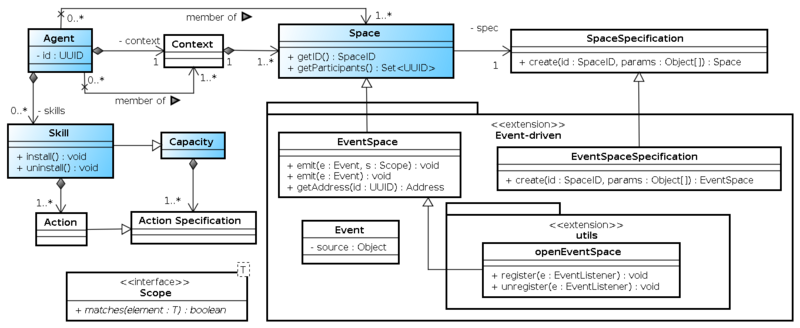
The Unified Modeling Language (UML) is a general-purpose, developmental, modeling language in the field of software engineering, that is intended to provide a standard way to visualize the design of a system.
The Web Services Business Process Execution Language (WS-BPEL), commonly known as BPEL, is an OASIS standard executable language for specifying actions within business processes with web services. Processes in BPEL export and import information by using web service interfaces exclusively.
A modeling language is any artificial language that can be used to express information or knowledge or systems in a structure that is defined by a consistent set of rules. The rules are used for interpretation of the meaning of components in the structure.
In computer science, dynamic dispatch is the process of selecting which implementation of a polymorphic operation to call at run time. It is commonly employed in, and considered a prime characteristic of, object-oriented programming (OOP) languages and systems.

A multi-agent system is a computerized system composed of multiple interacting intelligent agents. Multi-agent systems can solve problems that are difficult or impossible for an individual agent or a monolithic system to solve. Intelligence may include methodic, functional, procedural approaches, algorithmic search or reinforcement learning.

ATL is a model transformation language and toolkit developed and maintained by OBEO and AtlanMod. It was initiated by the AtlanMod team. In the field of Model-Driven Engineering (MDE), ATL provides ways to produce a set of target models from a set of source models.

A message sequence chart is an interaction diagram from the SDL family standardized by the International Telecommunication Union.
Kermeta is a modeling and programming language for metamodel engineering.
The Business Process Definition Metamodel (BPDM) is a standard definition of concepts used to express business process models, adopted by the OMG. Metamodels define concepts, relationships, and semantics for exchange of user models between different modeling tools. The exchange format is defined by XSD and XMI, a specification for transformation of OMG metamodels to XML. Pursuant to the OMG's policies, the metamodel is the result of an open process involving submissions by member organizations, following a Request for Proposal (RFP) issued in 2003. BPDM was adopted in initial form in July 2007, and finalized in July 2008.
Knowledge Discovery Metamodel (KDM) is a publicly available specification from the Object Management Group (OMG). KDM is a common intermediate representation for existing software systems and their operating environments, that defines common metadata required for deep semantic integration of Application Lifecycle Management tools. KDM was designed as the OMG's foundation for software modernization, IT portfolio management and software assurance. KDM uses OMG's Meta-Object Facility to define an XMI interchange format between tools that work with existing software as well as an abstract interface (API) for the next-generation assurance and modernization tools. KDM standardizes existing approaches to knowledge discovery in software engineering artifacts, also known as software mining.
The Semantics of Business Vocabulary and Business Rules (SBVR) is an adopted standard of the Object Management Group (OMG) intended to be the basis for formal and detailed natural language declarative description of a complex entity, such as a business. SBVR is intended to formalize complex compliance rules, such as operational rules for an enterprise, security policy, standard compliance, or regulatory compliance rules. Such formal vocabularies and rules can be interpreted and used by computer systems. SBVR is an integral part of the OMG's model-driven architecture (MDA).
In computing, aspect-oriented software development (AOSD) is a software development technology that seeks new modularizations of software systems in order to isolate secondary or supporting functions from the main program's business logic. AOSD allows multiple concerns to be expressed separately and automatically unified into working systems.
Domain-driven design (DDD) is an approach to software development for complex needs by connecting the implementation to an evolving model. The premise of domain-driven design is the following:
Automata-Based Programming is a programming technology. Its defining characteristic is the use of finite state machines to describe program behavior. The transition graphs of state machines are used in all stages of software development. Automata-Based Programming technology was introduced by Anatoly Shalyto in 1991. Switch-technology was developed to support automata-based programming. Automata-Based Programming is considered to be rather general purpose program development methodology than just another one finite state machine implementation.

IDEF4, or Integrated DEFinition for Object-Oriented Design, is an object-oriented design modeling language for the design of component-based client/server systems. It has been designed to support smooth transition from the application domain and requirements analysis models to the design and to actual source code generation. It specifies design objects with sufficient detail to enable source code generation.
Agent-based social simulation consists of social simulations that are based on agent-based modeling, and implemented using artificial agent technologies. Agent-based social simulation is scientific discipline concerned with simulation of social phenomena, using computer-based multiagent models. In these simulations, persons or group of persons are represented by agents. MABSS is combination of social science, multiagent simulation and computer simulation.
UML state machine, also known as UML statechart, is a significantly enhanced realization of the mathematical concept of a finite automaton in computer science applications as expressed in the Unified Modeling Language (UML) notation.
A language workbench is a software development tool designed to define, reuse and compose domain-specific languages together with their integrated development environment. Language workbenches support language-oriented programming. Language workbenches were introduced and popularized by Martin Fowler in 2005.






